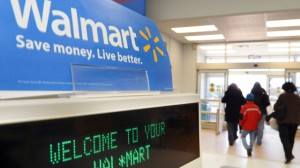On Wednesday, Bloomberg’s Renee Dudley reported that Wal-Mart, the nation’s largest private employer, is “looking at supporting an increase in the federal minimum wage, breaking with business and industry groups that oppose such a measure.” (That same day, Gap Inc., made a surprise announcement that it’s raising the minimum wage it pays its employees to $10 per hour by 2015.)
Wal-Mart is weighing the impact of additional payroll costs against possibly attracting more consumer dollars at its stores, David Tovar, a company spokesman, said today in a telephone interview. Increasing the minimum wage means that some of the 140 million people who shop at the chain weekly would “now have additional income,” Tovar said.
Dudley notes that there is precedent for such a move — in 2000, the company used its significant influence to back a minimum wage hike. If it were to do so again today, it would put Wal-Mart at odds with the National Retail Foundation, of which the company is a leading member.
A cynic might view the move as a way to shape a policy that Wal-Mart sees coming either way — perhaps the retailer will end up backing an increase to $9 per hour as a way of undermining President Obama’s call for a $10.10 per hour minimum. Or perhaps it sees it as a way to gain some positive public relations — last year, Wal-Mart sank $3 million into its “Real Wal-Mart” campaign to convince the public that it is a kindhearted company that loves its workers.
But that’s probably too cynical. The reality is that the company doesn’t only employ low-wage workers, it also relies on them for a decent chunk of its customer base. And with 95 percent of the income gains in the first four years of the recovery going to the top one percent of households, many of those customers are tapped out.
Earlier this month, Nelson Schwartz reported for The New York Times that businesses that cater to high-end clientele are doing great, but those that sell to working people are feeling the pinch. He wrote:
In 2012, the top 5 percent of earners were responsible for 38 percent of domestic consumption, up from 28 percent in 1995…Even more striking, the current recovery has been driven almost entirely by the upper crust… Since 2009, the year the recession ended, inflation-adjusted spending by this top echelon has risen 17 percent, compared with just 1 percent among the bottom 95 percent.
More broadly, about 90 percent of the overall increase in inflation-adjusted consumption between 2009 and 2012 was generated by the top 20 percent of households in terms of income.
By and large, those aren’t Wal-Mart shoppers.
Adding to the company’s problems is Washington’s shortsighted policymaking. Wal-Mart offered investors a gloomy forecast today, and as Reuters noted, “it blamed sharp cuts in food stamp benefits and higher payroll taxes that will hit disposable income for its core customers.” Wal-Mart gets over half of its sales from its grocery business.
With its relentless innovation in union-busting, and the “Wal-Mart effect” pushing down wages across its global supply chain, the Arkansas-based behemoth may have done more to squeeze the working class than any other firm. If it does decide to wield its considerable clout in support of a federal minimum wage hike, it won’t be a sign of sudden enlightenment — it will be the result of the company concluding that wages have fallen so low that its customers are struggling to buy its cheap imports.
But regardless of the company’s rationale, getting behind a pay raise for the working poor would help boost incomes for tens of million American workers. Let’s hope the company makes the right decision.



